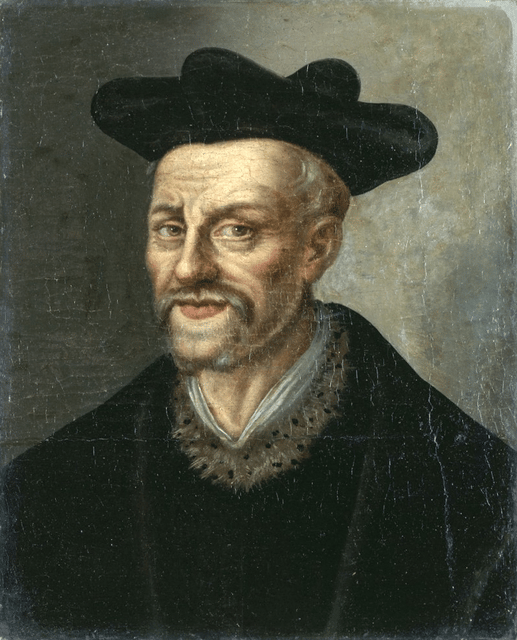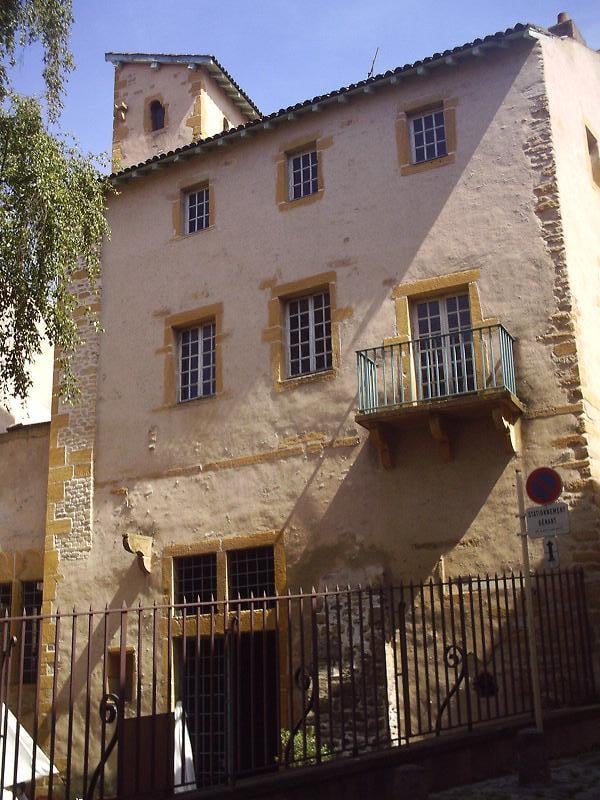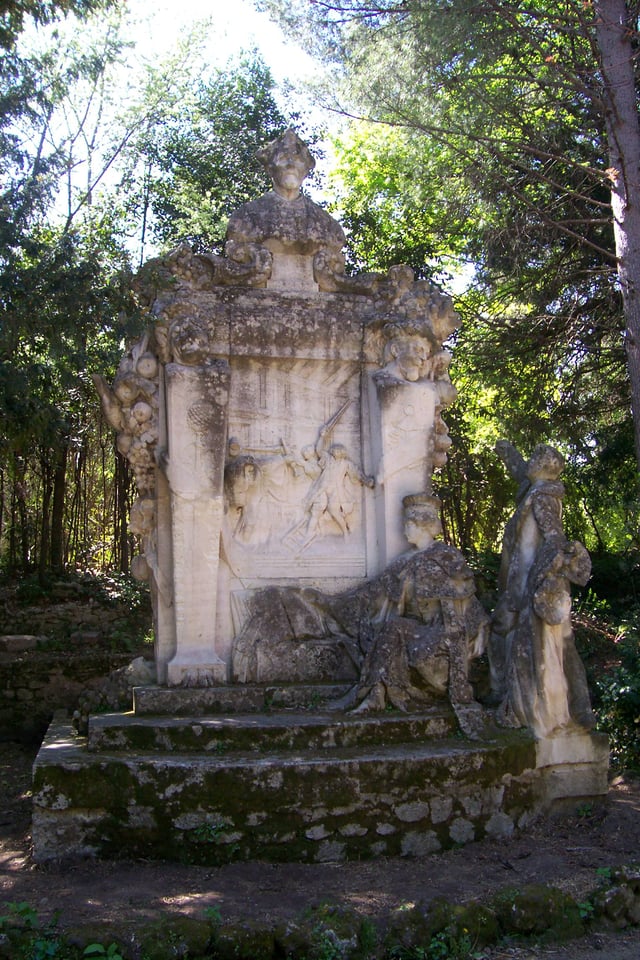François Rabelais

François Rabelais

François Rabelais | |
|---|---|
| Born | between 1483 and 1494 Chinon, Kingdom of France |
| Died | prior to 14 March 1553[1] (aged between 61 and 70) Paris, Kingdom of France |
| Occupation | Writer, physician, humanist |
| Nationality | French |
| Alma mater |
|
| Literary movement | Renaissance humanism |
| Notable works | Gargantua and Pantagruel |
François Rabelais (UK: /ˈræbəleɪ/ RAB-ə-lay, US: /ˌræbəˈleɪ/ -LAY,[2][3] French: [fʁɑ̃swa ʁablɛ]; between 1483 and 1494 – 1553) was a French Renaissance writer, physician, Renaissance humanist, monk and Greek scholar. He has historically been regarded as a writer of fantasy, satire, the grotesque, bawdy jokes and songs.
Because of his literary power and historical importance, Western literary critics consider him one of the great writers of world literature and among the creators of modern European writing.[4] His best known work is Gargantua and Pantagruel.
His literary legacy is such that the word Rabelaisian has been coined as a descriptive inspired by his work and life. Merriam-Webster defines the word as describing someone or something that is "marked by gross robust humor, extravagance of caricature, or bold naturalism".[5]
François Rabelais | |
|---|---|
| Born | between 1483 and 1494 Chinon, Kingdom of France |
| Died | prior to 14 March 1553[1] (aged between 61 and 70) Paris, Kingdom of France |
| Occupation | Writer, physician, humanist |
| Nationality | French |
| Alma mater |
|
| Literary movement | Renaissance humanism |
| Notable works | Gargantua and Pantagruel |
Biography

The house of François Rabelais in Metz
No reliable documentation of the place or date of the birth of François Rabelais has survived. While some scholars put the date as early as 1483, he was probably born in November 1494 near Chinon in the province of Touraine, where his father worked as a lawyer.[6][7] The estate of La Devinière in Seuilly in the modern-day Indre-et-Loire, allegedly the writer's birthplace, houses a Rabelais museum.
Rabelais became a novice of the Franciscan order, and later a friar at Fontenay-le-Comte in Poitou, where he studied Greek and Latin as well as science, philology, and law, already becoming known and respected by the humanists of his era, including Guillaume Budé (1467–1540). Harassed due to the directions of his studies and frustrated with the Franciscan order's ban on the study of Greek (because of Erasmus' commentary on the Greek version of the Gospel of Saint Luke),[8] [] Rabelais petitioned Pope Clement VII (in office 1523–1534) and gained permission to leave the Franciscans and to enter the Benedictine order at Maillezais in Poitou, where he was more warmly received.[9]
Later he left the monastery to study medicine at the University of Poitiers and at the University of Montpellier. In 1532 he moved to Lyon, one of the intellectual centres of the Renaissance, and in 1534 began working as a doctor at the Hôtel-Dieu de Lyon (hospital), for which he earned 40 livres a year. During his time in Lyon, he edited Latin works for the printer Sebastian Gryphius, and wrote a famous admiring letter to Erasmus to accompany the transmission of a Greek manuscript from the printer. Gryphius published Rabelais' translations & annotations of Hippocrates, Galen and Giovanni Manardo. As a physician, he used his spare time to write and publish humorous pamphlets critical of established authority and preoccupied with the educational and monastic mores of the time.[8] []
In 1532, under the pseudonym Alcofribas Nasier (an anagram of François Rabelais), he published his first book, Pantagruel King of the Dipsodes, the first of his Gargantua series. The idea of basing an allegory on the lives of giants came to Rabelais from the folklore legend of les Grandes chroniques du grand et énorme géant Gargantua, which were sold as popular literature at the time in the form of inexpensive pamphlets by colporters and at the fairs of Lyon.[8] [] Pantagruelisme is an "eat, drink and be merry" philosophy, which led his books into disfavor with the church, simultaneously brought them popular success and the admiration of later critics for their focus on the body. This first book, critical of the existing monastic and educational system, contains the first known occurrence in French of the words encyclopédie, caballe, progrès and utopie among others.[10][11] Despite the book's popularity, both it and the subsequent prequel book (1534) about the life and exploits of Pantagruel's father Gargantua were condemned by the "Sorbonne" in 1543 and the Roman Catholic Church in 1545.[12] [] Rabelais taught medicine at Montpellier in 1534 and again in 1539. In 1537, Rabelais gave an anatomy lesson at Lyon's Hôtel-Dieu using the corpse of a hanged man;[8] [] Etienne Dolet, with whom Rabelais was close at this time, wrote of these anatomy lessons in his Carmina.[1] [] In June 1543 Rabelais became a Master of Requests.[13]
Between 1545 and 1547 François Rabelais lived in Metz, then a free imperial city and a republic, to escape the condemnation by the University of Paris. In 1547, he became curate of Saint-Christophe-du-Jambet in Maine and of Meudon near Paris, from which he resigned in January 1553 before his death in Paris in April 1553.[8] []
With support from members of the prominent du Bellay family, Rabelais received approval from King Francis I to continue to publish his collection. However, after the king's death in 1547, the academic élite frowned upon Rabelais, and the French Parlement suspended the sale of his fourth book (Le Quart Livre) published in 1552.[8] [] [14]
Rabelais traveled frequently to Rome with his friend and patient Cardinal Jean du Bellay, and lived for a short time in Turin (1540– ) as part of the household of du Bellay's brother, Guillaume. Rabelais also spent some time lying low, under periodic threat of being condemned of heresy depending upon the health of his various protectors. Only the protection of du Bellay saved Rabelais after the condemnation of his novel by the Sorbonne.[8] []
Gargantua and Pantagruel

Illustration for Gargantua and Pantagruel by Gustave Doré.

Illustration for Gargantua and Pantagruel by Gustave Doré.
Gargantua and Pantagruel relates the adventures Gargantua and his son Pantagruel. The tales are adventurous and erudite, festive and gross, toxic ecumenical and rarely—if ever—solemn for long. The first book, chronologically, was Pantagruel and the Gargantua mentioned in the Prologue refers not to Rabelais' own work but to storybooks that were being sold at the Lyon fairs in the early 1530s.[15] [] In the first chapter of the earliest book, Pantagruel's lineage is listed back 60 generations to a giant named Chalbroth. The narrator dismisses the skeptics of the time—who would have thought a giant far too large for Noah's Ark—stating that Hurtaly (the giant reigning during the flood and a great fan of soup) simply rode the Ark like a kid on a rocking horse, or like a fat Swiss guy on a cannon.[15] [] In the Prologue to Gargantua the narrator addresses : "Most illustrious drinkers, and you the most precious pox-ridden—for to you and you alone are my writings dedicated ..." before turning to Plato's Banquet.[15] [] An unprecedented syphilis epidemic had raged through Europe for over 30 years when the book was published,[16] even the king of France was reputed to have been infected. Etion was the first giant in Pantagruel's list of ancestors to suffer from the disease.[15] []
Although most chapters are humorous, wildly fantastic and frequently absurd, a few relatively serious passages have become famous for expressing humanistic ideals of the time. In particular, the chapters on Gargantua's boyhood and Gargantua's paternal letter to Pantagruel[17] [] present a quite detailed vision of education.
Thélème

Titlepage of a 1571 edition containing the last three books of Pantagruel: Le Tiers Livre des Faits & Dits Heroïques du Bon Pantagruel (The Third Book of the True and Reputed Heroic Deeds of the Noble Pantagruel)
In the first book, M. Alcofribas narrates the Abbey of Thélème, built by the giant Gargantua. It differs remarkably from the monastic norm, as the abbey is open to both monks and nuns, has a swimming pool, maid service, and no clocks in sight. Only the good-looking are permitted to enter.[15] [] The inscription on the gate to the abbey first sets out who is unwelcome: hypocrites, bigots, the pox-ridden, Gothz, Magothz, the straw-chewing law clerks, usurious grinches, old or officious judges, and burners of heretics.[15] [] When the members are defined positively, the text becomes more inviting:
The Thélèmites in the abbey live according to a single rule: DO WHAT YOU WANT.
Third Book
There are few speaking roles for women in the Rabelaisian adventures: Pantagruel's mother dies in childbirth; Gargantua's mother (Gargamelle) fades from the story as soon as the newborn giant has climbed through her ear out into life. Le Tiers Livre—whose major theme is whether Panurge should marry or not—is no exception to this rule. This book was published under Rabelais' own name in 1546 and was also banned by the Sorbonne. It revisited discussions he had had while working as a secretary to Geoffroy d'Estissac earlier in Poitiers, where la querelle des femmes had been a lively subject of debate.[8] [] More recent exchanges with Marguerite de Navarre before she wrote the Heptameron led Rabelais to dedicate the book to her.[18]
Use of language
The French Renaissance was a time of linguistic contact and debate. The first book of French, rather than Latin, grammar was published in 1530,[19] followed nine years later by the language's first dictionary.[20] Spelling was far less codified back then. Rabelais, as an educated reader of the day, preferred etymological spelling which preserved words' histories to more phonetic spellings which would wash them away.
Rabelais' use of Latin, Greek, regional and dialectal terms, creative calquing, gloss, neologism and mis-translation was the fruit of the printing press having been invented less than a hundred years earlier. A doctor by trade, Rabelais was a prolific reader, who wrote a great deal about bodies and all they excrete or ingest. His fictional works are filled with multilingual, often sexual, puns, absurd creatures, bawdy songs and lists. Words and metaphors from Rabelais abound in modern French and some words, as mentioned above, have even found their way into English, through Thomas Urquhart's 1693 translation.
Scholarly views
Most scholars today agree that the French author wrote from a perspective of Christian humanism.[21] This has not always been the case. Abel Lefranc, in his 1922 introduction to Pantagruel, depicted Rabelais as a militant anti-Christian atheist.[22] M. A. Screech, like Lucien Febvre before him,[9] [] describes Rabelais as an Erasmian.[23]
Rabelais was Roman Catholic. Timothy Hampton writes that "to a degree unequaled by the case of any other writer from the European Renaissance, the reception of Rabelais's work has involved dispute, critical disagreement, and ... scholarly wrangling ..."[24] But at present, "whatever controversy still surrounds Rabelais studies can be found above all in the application of feminist theories to Rabelais criticism".[25]
Citing Jean de La Bruyère, the Catholic Encyclopedia of 1911 wrote of Rabelais as:
... a revolutionary who attacked all the past, Scholasticism, the monks; his religion is scarcely more than that of a spiritually-minded pagan. Less bold in political matters, he cared little for liberty; his ideal was a tyrant who loves peace. [...] His vocabulary is rich and picturesque, but licentious and filthy. In short, as La Bruyère says: "His book is a riddle which may be considered inexplicable. Where it is bad, it is beyond the worst; it has the charm of the rabble; where it is good it is excellent and exquisite; it may be the daintiest of dishes." As a whole it exercises a baneful influence.[26]
In literature
In his novel Tristram Shandy, Laurence Sterne quotes extensively from Rabelais.[27]
Alfred Jarry performed, from memory, hymns of Rabelais at Symbolist Rachilde's Tuesday salons. Jarry worked for years on an unfinished libretto for an opera by Claude Terrasse based on Pantagruel.[28]
Anatole France lectured on him in Argentina. John Cowper Powys, D. B. Wyndham-Lewis, and Lucien Febvre (one of the founders of the French historical school Annales), all wrote books about him.
George Orwell was not an admirer of Rabelais. Writing in 1940, he called him "an exceptionally perverse, morbid writer, a case for psychoanalysis".[29]
Milan Kundera, in a 2007 article in The New Yorker, commented on a list of the most notable works of French literature, noting with surprise and indignation that Rabelais was placed behind Charles de Gaulle's war memoirs, and was denied the "aura of a founding figure! Yet in the eyes of nearly every great novelist of our time he is, along with Cervantes, the founder of an entire art, the art of the novel".[30]
Rabelais is treated as a pivotal figure in Kenzaburō Ōe's acceptance speech for the Nobel Prize in Literature in 1994.[31]
Honours, tributes and legacy

Bust of Rabelais in Meudon, where he served as Curé

Monument to Rabelais at Montpellier's Jardin des Plantes
The public university in Tours, France is named Université François Rabelais.
Honoré de Balzac was inspired by the works of Rabelais to write Les Cent Contes Drolatiques (The Hundred Humorous Tales). Balzac also pays homage to Rabelais by quoting him in more than twenty novels and the short stories of La Comédie humaine (The Human Comedy). Michel Brix wrote of Balzac that he "is obviously a son or grandson of Rabelais... He has never hidden his admiration for the author of Gargantua that he cites in Le Cousin Pons as "the greatest mind of modern humanity".[32][33] In his story of Zéro, Conte Fantastique published in La Silhouette on 3 October 1830, Balzac even adopted Rabelais's pseudonym (Alcofribas)[34].
Rabelais also left a tradition at the University of Montpellier's Faculty of Medicine: no graduating medic can undergo a convocation without taking an oath under Rabelais's robe. Further tributes are paid to him in other traditions of the university, such as its faluche, a distinctive student headcap styled in his honour with four bands of colour emanating from its centre.[35]
Asteroid '5666 Rabelais' was named in honor of François Rabelais in 1982.[36]
In Jean-Marie Gustave Le Clézio's 2008 Nobel Prize lecture, Le Clézio referred to Rabelais as "the greatest writer in the French language".[37]
In France the moment at a restaurant when the waiter presents the bill is still sometimes called le quart d'heure de Rabelais, in memory of a famous trick Rabelais used to get out of paying a tavern bill when he had no money.[38][39]
Works
Gargantua and Pantagruel, a series of four or five books including: Pantagruel (1532) La vie très horrifique du grand Gargantua, usually called Gargantua (1534) Le Tiers Livre ("The third book", 1546) Le Quart Livre ("The fourth book", 1552) Le Cinquiesme Livre (a fifth book, whose authorship is contested)
See also
Rabelais and His World
Thomas Urquhart